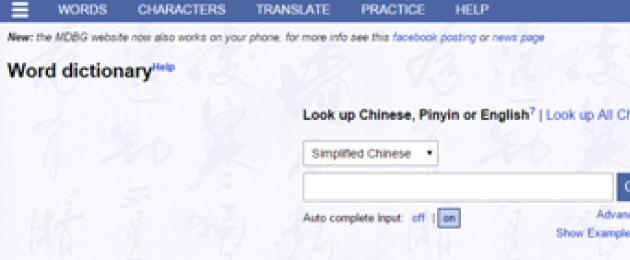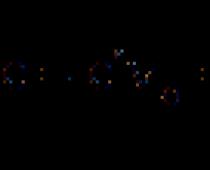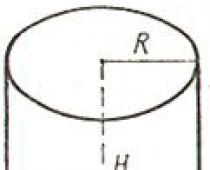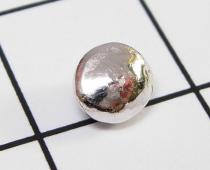The purpose of the educational dictionary is to facilitate the first steps in mastering Chinese writing. The dictionary includes more than 300 of the most common hieroglyphs and about 2,500 words and phrases. The publication is modeled after the Chinese teaching aids and dictionaries for schoolchildren with explanations of keys arranged thematically. The dictionary is intended for those starting to study the Chinese language, as well as for everyone interested in the origin of Chinese writing.
Introduction.
What is a Chinese character?
Unlike Russian letters, which denote certain sounds, the Chinese character denotes a concept. Since there are many more concepts than sounds, there are many more hieroglyphs than letters. Each hieroglyph records not only a concept, but also the sounds with which this concept is associated. These sounds and concepts were recorded at first using simple drawings, but gradually they turned into diagrams in which it is difficult to recognize the original drawing. Thus, each hieroglyph can have three aspects. The first aspect is graphic. This is a schematic drawing consisting of individual features (graphic elements - see p. 7).
The second aspect is semantic. It is the aspect of a concept or meaning that is different languages may appear in more or less the same form. For example, in Chinese, Japanese and other languages that use hieroglyphs, the hieroglyph means “person”. The third aspect is phonetic. This is a pronunciation that “looks” different in each language. The Chinese reading of each character is one and one syllable only. Graphics and semantics in historical development hieroglyphs appear in unity. Not only the complex hieroglyph as a whole, but also individual graphemes carry a certain semantic load. In the ancient language this connection was stronger, since hieroglyphs came from pictures. It is impossible to determine just by the appearance of a modern hieroglyph what it means, but some hints of it can still be found.
From the authors.
Introduction.
Dictionary.
Space.
Time.
Movement.
Number.
Nature.
Signs.
Plants.
Animals.
Human.
Human life and activity.
Labor results.
Negation.
Graphic elements - keys.
Table of cyclic signs.
Table of hieroglyphic keys.
Alphabetical index.
List of hieroglyphs.
Bibliography.
Free download e-book in a convenient format, watch and read:
Download the book Chinese-Russian educational dictionary of hieroglyphs, Wang L., Starostina S.P., 2013 - fileskachat.com, fast and free download.
Download pdf
Below you can buy this book at the best price with a discount with delivery throughout Russia.
This is one of the strange entries on my blog - the blog of an English teacher. The fact is that I am studying Chinese in Chinese language courses at the Dmitry Nikitin School in Yaroslavl. I have already written about the tactics and methods that I use to learn Chinese more effectively in a post. And today I would like to talk about educational dictionaries of the Chinese language, which help me in the fascinating task of learning Chinese.
I’ll immediately make a reservation that (it just so happens) I know English quite well, and therefore most of the Chinese dictionaries that I use contain comments mainly in English.
Chinese dictionaries based on English
- a convenient interface with a lot of “air”, and therefore the dictionary is very easy to use;
- the dictionary recognizes handwriting;
- determines the order of lines in a Chinese character;
- In the dictionary, each hieroglyph is voiced.
- sometimes translated into English language is inaccurate, which I learn about in classes with a Chinese tutor. This, however, can be said of all Chinese translation dictionaries and can probably be explained by the enormous cultural difference between European and Asian languages.

I use this Chinese dictionary to determine the etymology of a Chinese word, identify components Chinese characters.
Pros of this Chinese dictionary:
- you can click on a part of the hieroglyph, and you will be shown one of its components;
- The etymology of Chinese characters in English is very well covered.
Disadvantage of this Chinese dictionary:
- terrible, confusing interface.

I use this Chinese dictionary to determine the sound of Chinese characters, study the order of lines in Chinese characters, determine the frequency of a particular Chinese character, and memorize common phrases with Chinese characters. The latter is especially important to me, since I believe that any foreign language must be learned by memorizing phrases and set expressions, what I write about in the entries , , .
Pros of this Chinese dictionary:
- the constituent components of Chinese characters and the order of lines are clearly visible;
- phrases with Chinese characters are given;
- the pronunciation of both Chinese characters and their component parts is demonstrated;
- The frequency of use of hieroglyphs is indicated.

I use this Chinese dictionary to break down Chinese characters into their component parts, so you can memorize the characters more effectively.
Pros of this Chinese dictionary:
- the information is structured in the form of a tree, so the connection between one Chinese character and another is clearly visible.
I did not find any disadvantages of this Chinese dictionary.

I use this Chinese dictionary to determine the dictionary meaning of Chinese characters, clarify the meaning of jargon, clarify the meaning of professional and academic Chinese vocabulary.
Pros of this Chinese dictionary:
- very good for translating texts from Chinese to other languages and from other languages to Chinese.
This Chinese dictionary has no downsides. A very useful site for Chinese language learners.

Educational explanatory dictionaries of the Chinese language
I use this Chinese dictionary to look up the meaning of Chinese idioms, set expressions and anything else that I couldn't find in other Chinese dictionaries.
Pros of this Chinese dictionary:
- this Chinese dictionary is user-edited (like Wikipedia), making it quite modern and colloquial;
- all necessary actions are intuitively clear.
Disadvantage of this Chinese dictionary:

I use this Chinese dictionary as my main one.
Pros of this Chinese dictionary:
- shows the procedure for writing a hieroglyph;
- allows you to hear the pronunciation of the hieroglyph;
- gives the meaning of the hieroglyph;
- offers options for stable combinations with the given hieroglyph;
- demonstrates the historical spelling of the hieroglyph and the transformation of the spelling;
- The mobile version is downloaded using the QR code posted on the website.
I did not find any disadvantages of this Chinese dictionary.
1) Large Chinese-Russian dictionary (printed version)
You can buy it, for example, on Ozone. There is a BCRS by Z. I. Baranova, V. E. Gladtskov, V. A. Zhavoronkov, B. G. Mudrov for 150,000 words:
and BCRS for 450,000 words (this is a dictionary not only Chinese-Russian, but also Russian-Chinese):
In the dictionary we start searching by keys. Everything is quite simple: we look at the hieroglyph, determine the key, count the number of features in the key, open the list of keys and now you are sent to page, say 765, where all the hieroglyphs with these keys are located.
Now we count the number of strokes in the second part of the hieroglyph, say 7. On page 765 we find our key plus 7 strokes of the second part and now we are again sent to the page for translation, say 1465.
This is undoubtedly a very long option. There are other dictionaries that work on different principles, although it mainly comes down to counting features. There are also dictionaries in which hieroglyphs are arranged according to the Latin alphabet by their sound. It's actually useful if you know pinyin but don't know the meaning, which isn't the problem.
2) computer program Lingvo
Download Lingvo, purchase a license, install the Chinese language, not forgetting to set the permission for the visibility of hieroglyphs in Windows (start-control panel-language and regional standards - languages-install support for languages with hieroglyph writing, insert the Windows installation disk. After copying the files, restart the computer) .
The latest version of Lingvo contains not only Chinese-Russian dictionaries, but also Chinese-English and English-Chinese dictionaries, as well as Chinese-Russian and Russian-Chinese phrasebooks. If you don’t have Russian-Chinese dictionaries, we’ll type Russian word in the Chinese-Russian dictionary, and a search will begin in all articles, which can be quite effective.
- (Japanese 大漢和辞典 Dai kan wa jiten?) the world's largest Japanese dictionary of Chinese characters, compiled by a team of authors led by Tetsuji Morohashi from 1925 to 1960. The dictionary contains more than 50 thousand individual hieroglyphs and 530 thousand... ... Wikipedia
This article uses fonts from Asian languages. Read more... Simplification of characters (Chinese: 简化字, pinyin: jiǎnhuà zì) the process of developing and implementing new writing standards in the People's Republic of China, and then in other countries,... ... Wikipedia
- (Chinese trad. 中华字海, ex. 中華字海, pinyin: zhōng huá zì hǎi) the largest printed dictionary of Chinese characters, compiled in 1994 and consisting of 85,568 characters. Contents... Wikipedia
Contents: Geography. General history. History of relations between Kazakhstan and Europe. Language and literature. Chinese music. great empire Eastern and central Asia is known among its inhabitants under names that have nothing in common with European ones (China, China, ... ... encyclopedic Dictionary F. Brockhaus and I.A. Efron
Chinese People's Republic, PRC, state in the Center, and East. Asia. The name China adopted in Russia comes from the ethnonym Khitan (aka China) of the Mong group. tribes that conquered the northern territory in the Middle Ages. regions of modern times China and formed the state of Liao (X... ... Geographical encyclopedia
Self-name: 日本語 Countries: Japan, Guam, Taiwan, North Korea ... Wikipedia
Japanese language Self-name: 日本語 Countries: Japan, Guam, Taiwan, DPRK, South Korea, Peru, Australia. Official status: Japan Regulatory organization ... Wikipedia
Language Self-name: 日本語 Countries: Japan, Guam, Taiwan, North Korea, South Korea, Peru, Australia. Official status: Japan Regulatory organization ... Wikipedia
Books
- Large Chinese-Russian dictionary (set of 4 books), V. A. Panasyuk, V. F. Sukhanov. The "Big Chinese-Russian Dictionary" includes about 16 thousand nested hieroglyphs and over 250 thousand derivative words and expressions. The dictionary was created on the basis of the Chinese dictionaries “Guoyu Qidian”,…
Sometimes you need to know the interpretation of a word in order to use it correctly in context, for this there are Chinese explanatory dictionaries, they give an interpretation of words in Chinese, which is very useful for intensive study. The most popular dictionaries in this category are Zdic (http://www.zdic.net/) and Baidu Dictionary (°Ш¶ИґКµд) (http://dict.baidu.com/).
Zdic - this dictionary provides detailed definitions, interpretations, etymology, order of features, English translation and detailed information on each hieroglyph separately.
Baidu Dictionary (°ШЧ¶ИґКµд) - In fact, Baidu is a huge search engine, for example, like we have Yandex, and it also has its own dictionaries, so translators with a good command of the language can make search queries there and receive answers accordingly. This online dictionary contains a huge number of idioms, proverbs, established expressions and other words that are often not found in other dictionaries. Constantly updated by users, quite detailed and simple to design.
Online dictionaries for translation into Traditional Chinese
There are also online dictionaries for translation into traditional Chinese; such dictionaries are more suitable for professionals than for beginners, people who are working with wenyan not for the first time. Chinese spell checker (http://www.kwuntung.net) - in this dictionary you can check the use of hieroglyph variants in in different words; Dictionary of hieroglyphic variants (http://dict2.variants.moe.edu.tw/variants/) - this dictionary searches for different (outdated) variants of hieroglyphs, an indispensable site for advanced translators. The only negative is that it is not easy to use, and sometimes gives unclear interpretations; Chinese Dictionary of the Ministry of Education of Taiwan (http://dict.revised.moe.edu.tw/) - This dictionary is good to use for looking up words that cannot be found anywhere, as well as for finding detailed information on hieroglyphs. Compared to other dictionaries, it is very detailed. Sometimes it contains old examples, complex explanations, too detailed interpretations, so it may be difficult for beginners to use; Taiwan Ministry of Education Dictionary for primary school(http://dict.mini.moe.edu) - This dictionary contains interpretations of single characters and phrases in Chinese, more understandable than the Chinese Dictionary of the Ministry of Education of Taiwan. But the inconvenience of use lies only in the fact that the search is possible only by single hieroglyphs; Dictionary of the Ministry of Education of Taiwan on the order of writing characters (http://stroke-order.learningweb.moe.edu) - This dictionary can check the order of strokes in a character and the current writing standard in Taiwan, the dictionary is quite detailed and well structured.
- In contact with 0
- Google+ 0
- OK 0
- Facebook 0








